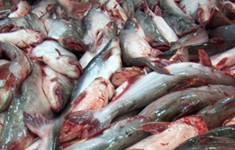 China is aiming to boost local catfish production to take advantage of falling U.S. output, while also tapping the domestic Chinese market, according to a state-run research organization in one of China’s key catfish cultivation regions. The Hubei Province Aquatic Products Scientific Research Institute, in a recent research report, notes that a fall in American channel catfish production means a decline in shipments of American channel catfish: “Those countries who import catfish from America could not satisfy its market demands [with American catfish], therefore … our catfish should also try to export to eastern European countries, Mexico, Russia, Middle Eastern countries … African countries and South America.”
China is aiming to boost local catfish production to take advantage of falling U.S. output, while also tapping the domestic Chinese market, according to a state-run research organization in one of China’s key catfish cultivation regions. The Hubei Province Aquatic Products Scientific Research Institute, in a recent research report, notes that a fall in American channel catfish production means a decline in shipments of American channel catfish: “Those countries who import catfish from America could not satisfy its market demands [with American catfish], therefore … our catfish should also try to export to eastern European countries, Mexico, Russia, Middle Eastern countries … African countries and South America.”The report, co-authored by Hubei researcher Cai Yanzhi along with Xiao Youhong at National Fishery Technical Extension Station (a national extension service under the ministry of agriculture) noted that current annual processing of channel catfish amounts to 150,000 to 200,000 tons, with live fish sales at 100,000 tons. However, China’s exports of channel catfish face “huge roadblocks” according to Cai and Xiao, who pointed to “a tightening of the American food safety code and a low world economy and domestic protection of channel catfish industry in America … Therefore we have to explore the channels to export our products to other countries.”
Chinese catfish processors should also tap the domestic market, to cushion against unstable market prices and rising costs, say the report writers. “The most important challenge to processors is to find the way to open the domestic market. And to figure that out, these companies have to understand the market’s demands … Catfish could enter the market like codfish did before … we have to fit the needs of niche consumers, like: elderly people, kindergarten students and we should have multi-produced ways to fit the different needs of different people.”
Cai and Xiao also call for standards in the processing sector. “There should be a standard in processing the channel catfish fillets. There are flaws in controlling microbes and heavy-metals,” says the article, which also calls for the processing of byproducts — fish skin, fish bones, internal organs — for fish oil and fish liver oil.
The report also addresses problems in China’s channel catfish farms. “The cultivated descendants of channel catfish is small sized, slow growing-speed and lower disease resistivity so it has a high disease-attack rate,” says the article, which blames “high culturing density and lack of culturing standardization” for the problems.
According to the two researchers, China first imported channel catfish from America in 1984, reproduced it in 1987 and started to culture in ponds in 1988 in whole China. In 1993 China started to culture the fish in cages and in 2003 cultured in large scale. In 2000 China started exporting the channel catfish to America.
Food safety should be key to future development of the catfish sector, the researchers said. “Both the culture companies and processed companies have to pay more attention on this in order to build a worldwide brand.” They are notably introspective in detailing the source of food safety problems for Chinese catfish farms. Those problems peaked in 2007, when the U.S. Food and Drug Administration put an import alert on all Chinese catfish after detecting carcinogens malachite green and crystal violet in sampled fish. “In 2007, the U.S. started to automatically check the residue in the fish and only if they suit the standards could they be released to the market. This made the scale of exports decline sharply.”
According to the U.S. Department of Agriculture, China’s total cultured catfish production was estimated at 610,000 tons in 2012, a lift from 598,000 tons in 2011 “in response to dynamic domestic consumption.” However farmed catfish output for export “remains soft in response to uncertainty regarding pending U.S. import policies.” Cai and Xiao are upbeat on the potential for China’s catfish sector. “Channel catfish has little bone … it has high-quality meat, high protein content, it is one of the few fresh-water fishes which suits large-scaled processing.”
China’s plans will face competition from the popularity of Vietnam’s basa fish (also known as Vietnamese catfish, sole and pangasius) which has become one of the most exported seafood items, farmed in the Mekong River. While Vietnamese fish farmers have drawn criticism for feed and antibiotic use, the pollution in Chinese rivers challenges future output there.
Aims to target the domestic market may be well-placed however. On visits to supermarkets in Beijing SeafoodSource saw shoppers at Carrefour and WalMart outlets buying cut-price frozen “sole” (the Chinese name on the label, long lin yu, confirmed it’s catfish) processed by Thai conglomerate Charoen Pokphand in Vietnam at RMB 22 (USD 3.57, EUR 2.70) for 700 grams. Likewise, catfish has in recent years displaced other species as an affordable input for Shui zhu yu (fish in soup with red chilli peppers), a hugely popular dish in Sichuan-style restaurants dotting Beijing’s busy Gui Jie dining strip.





